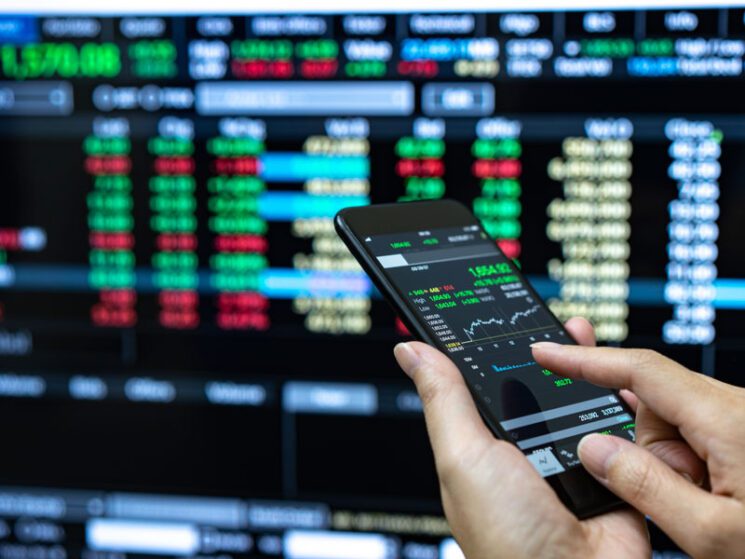Welcome to the thrilling, high-stakes world of Bitcoin trading. As this digital gold gains traction and becomes more mainstream, many traders are considering leaping to full-time trading. But when is the right time to do so? This guide aims to help you navigate this question, analyze benefits and challenges, and offer actionable advice to prepare you for this significant transition.
Trading Bitcoin full-time has its undeniable allure. Financial freedom, the ability to work from anywhere, and the thrill of making strategic decisions that could result in considerable profits are all enticing aspects of this career path. However, the journey also comes with inherent risks and demands, including financial instability and the emotional toll of trading volatility.
In This Post
Understanding Your Trading Performance

To consider scaling your Bitcoin trading venture to a full-time occupation, understanding your performance is essential. The ability to assess your strategy and track record over a significant period is the cornerstone of this process. You need to understand how your strategies fare in different market conditions and whether they consistently yield profits.
Analyzing your risk management practices is equally crucial. Profitable trading isn’t just about making big wins but also about limiting losses. Key indicators that signal readiness for full-time trading include a consistently high win-to-loss ratio, stable equity growth, and a satisfactory Sharpe ratio, which measures the return on investment compared to its risk.
Building a Solid Plan
Having a detailed trading plan is a key factor for success in working with Bitcoin. This plan should detail your strategies, risk management protocols, and financial goals. It serves as your roadmap, guiding your decisions and helping to remove emotion from the equation.
Risk management is particularly vital when scaling your operation. An effective risk management strategy could involve setting stop-loss and take-profit levels, only risking a small percentage of your capital per trade, or diversifying your portfolio. If you’re having issues with generating a plan seeking professional help should be your next move and help can be found at https://bitgratitude.com/.
Financial Preparedness
Financial preparedness is a crucial aspect of transitioning to full-time trading. Before leaping, evaluate your financial situation thoroughly. Can you afford to live without a regular paycheck? Do you have enough savings to sustain you during losing streaks? Your capital should be money you can afford to lose without jeopardizing your financial stability.
Setting financial goals and calculating the capital required to achieve them is the next step. This provides clarity on how much you need to make each month to sustain your lifestyle and meet your obligations. This can guide your decisions, helping you to aim for realistic profits rather than taking unnecessary risks.
Balancing Trading and Other Commitments

Balancing trading with other commitments, such as a day job or family responsibilities, is a challenge faced by many aspiring full-time traders. Effective time management and setting priorities are crucial in this regard. Initially, you may have to trade part-time while maintaining your day job, gradually scaling your entire venture as you gain more confidence and profitability.
Trading demands mental agility and focus, making it hard to do effectively in your spare time. Therefore, consider the pros and cons of going full-time carefully. If your financial situation allows, dedicating full time to trading may accelerate your learning curve and increase your chances of success.
Expanding Your Knowledge and Skills
Trading is a continuous learning process. Markets evolve, new strategies emerge, and regulatory environments change. To stay ahead, constantly expanding your knowledge and refining your skills is paramount.
Books, online courses, and webinars are excellent resources for enhancing your understanding of technical analysis, market indicators, and trading psychology. Additionally, networking with other traders and participating in in-domain communities can provide invaluable insights and real-world learning opportunities.
Evaluating Market Conditions
Successful traders never stop evaluating market conditions. Before transitioning to full-time trading, understanding how different market scenarios impact your strategies is essential. This includes understanding market cycles, volatility patterns, and the effect of macroeconomic events on Bitcoin prices.
Market analysis skills are critical here. Both technical analysis, which involves studying price charts and indicators, and fundamental analysis, which considers broader economic factors, are necessary for comprehensive market evaluation.
Establishing Emotional Resilience

Emotional resilience is perhaps the most underrated yet crucial aspect of full-time trading. The world of Bitcoin trading can be a roller-coaster of highs and lows, and being able to manage emotions such as stress, anxiety, and fear is paramount.
Developing emotional resilience involves creating a robust plan and strictly adhering to it, practicing mindfulness, and maintaining a balanced lifestyle outside trading.
Diversifying Your Portfolio
Diversification is a powerful strategy to mitigate risks in your trading portfolio. This could involve diversifying strategies to adapt to different market conditions or diversifying assets to spread risk across different cryptocurrencies.
However, diversification has its complexities. Trading a wide range of assets requires a deep understanding of different markets, and diversifying strategies can make it harder to master any single one. Therefore, diversification should be approached thoughtfully and strategically.
Seeking Professional Guidance
No matter how confident you are in your trading abilities, seeking advice from experienced traders or financial advisors can be incredibly beneficial. They can provide valuable insights, help refine your plan, and offer guidance on managing personal finances.
Consider seeking mentorship from a successful trader. A mentor’s real-world experience can provide practical lessons that books and courses cannot. Learning from their successes and failures can accelerate your journey toward becoming a proficient full-time trader.
Monitoring and Reviewing Progress
Monitoring and reviewing progress is a continuous process that helps you gauge the effectiveness of your trading strategies and manage your performance. This involves tracking trade outcomes, analyzing winning and losing trades, and regularly reviewing your plan.
Tools such as trading journals and performance analytics can provide valuable insights into your trading patterns, strengths, and areas for improvement. Remember, the goal is not to win every trade but to ensure a profitable overall track record.
Making the Decision: Full-Time Trading or Not

Deciding to transition to full-time Bitcoin trading is a deeply personal decision that hinges on several factors: your financial preparedness, trading performance, emotional resilience, and personal commitments. The goal is not to make this decision hastily but to give it the careful thought and analysis it deserves.
Assess your readiness honestly, reflecting on your personal goals, risk tolerance, and life situation. The decision to trade full-time should align with your long-term financial goals and personal aspirations.
Bottom Line
Full-time trading is a challenging yet potentially rewarding career path. The journey demands resilience, continuous learning, and careful planning. The risk is significant, but so too is the potential for great reward. By being mindful of the guidelines and considerations laid out in this guide, you’ll be well-equipped to make an informed decision about when to scale your Bitcoin trading venture to a full-time pursuit.